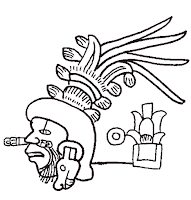We're not saying it's aliens, but...
You may have heard that before. What is still known as the History channel (for some reason) has lots of shows dealing with the concept of ancient aliens and the like. It should go without saying that most archaeologists hate this theory, but they also reject much of what we suggest concerning the Book of Mormon and ancient history. It may be useful at times to see what is happening in the fringe areas of pseudoscience. Oddly enough, sometimes the Book of Mormon or other experiences of Joseph Smith are mentioned on these programs. They do at times find anomalies like advanced cultural artifacts, lost civilizations, ties to the Old World, or even writing on metal plates. While their standard answer is often aliens, we may have a more plausible explanation.
There are a number of unusual skulls that have been excavated from ancient burial sites in the Americas. It is well known that for some reason, both Old and New World peoples with no apparent ties practiced cranial deformation to elongate their skulls, starting with infants. Some ancient American skulls look so unusual that again the alien hypothesis is brought up. Recently, DNA studies gave some surprising results and have raised questions about how the Americas were populated in antiquity.
In 2014, DNA tests were performed on 2000-3000-year-old skulls found in Peru. Hundreds were found in Paracas by a Peruvian archaeologist in the 1920s. The initial results found mitochondrial DNA “with mutations unknown in any human, primate, or animal known." To get a better idea of what was really happening with these ancient skulls, a second round of DNA tests was undertaken. Samples of hair and bone powder were taken and sent to three labs in Canada and two in the US. Geneticist at these labs were told that the samples were from ancient mummies, but the origins were not given. This nod to blind testing is commendable, as it avoids preconceptions that could influence the results or how they are interpreted.
The second set of tests were performed in 2016, with the results showing European and Middle Eastern Origins. Not surprisingly, not much more attention is given to these revolutionary findings. They are often explained away if not ignored outright. However, if true, it would mean that the accepted population history of Ancient America would need some serious re-evaluation. Scientists have always been reluctant to do so, even though some claim they are open to the question. On the subject, once scientist has commented, "It is of course possible that genetic evidence of an ancient trans-Atlantic migration event simply has not been found yet. Should credible evidence of direct gene flow from an ancient Solutrean (or Middle Eastern) population be found within ancient Native American genomes, it would require the field to reassess the “Beringian only” model of prehistoric Native American migration. However, no such evidence has been found, and the Beringian migration model remains the best interpretation of the genetic, archaeological, and paleoclimate data to date."
As we question the standard historical answer of how the Americas were populated, we need to keep these issues in mind. Often, controversial claims regarding DNA are hard to understand by non-geneticists. But the genetic record in the Americas was drastically altered after the European conquest, sometimes through violence, but more often through disease. According to lead researcher Antonio Salas of the University of Santiago de Compostela, “Up to 90% of native South Americans died very quickly...You can imagine that a lot of genetic diversity was lost as well.”










